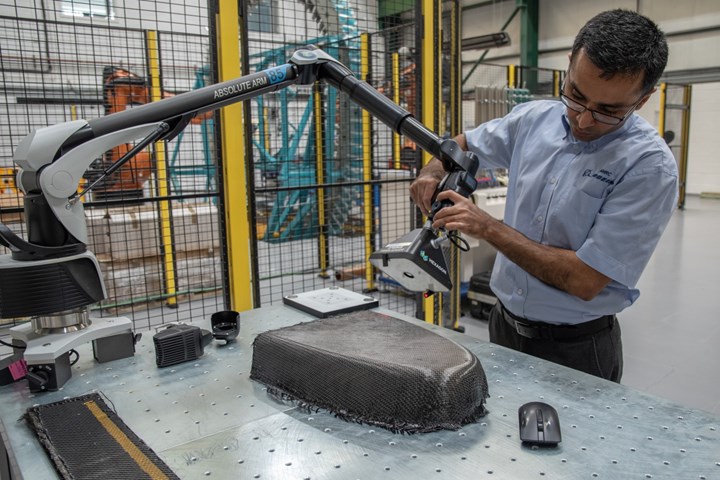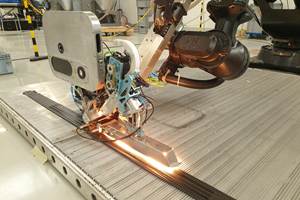Hexagon vision inspection eliminates manual inspection process
According to AMRC’s case study, Hexagon’s composite inspection technology uses 3D modeling to scan and map fiber orientation data, generating a 3D profile of the part being inspected.

Zeeshan Qureshi, lead research engineer on the Design Analysis and Composite Automation team at the AMRC Composite Centre. Source | AMRC
It was recently reported from a case study done by researchers at the University of Sheffield Advanced Manufacturing Research Centre (AMRC; Rotherham, U.K.) that a vision inspection system using 3D modeling from Hexagon Composites (Alesund, Norway) could save composite manufacturers time and money by eliminating the manual inspection process of composite materials and parts.
“Quality checks during the layup process are vital but can take 70% or more of total machine time,” says Zeeshan Qureshi, lead research engineer on the Design Analysis and Composite Automation team at the AMRC Composite Centre. “It is a huge cost to our partners so we’re investigating automated in-process inspection systems that could help significantly decrease, or even eliminate entirely, manual inspection in order for them to achieve higher productivity in their factories.”
Qureshi points to the alignment of fibers when layering plies of unidirectional or woven fabric, and how detecting defects, from gaps and overlaps, to the presence of foreign objects and debris at a relatively early layup stage of production would much more efficient and cost-effective than identifying unacceptable weak points in the material once it is part of a completed component.
As a result, he says, the Composite Centre researched what systems were being successfully employed in related applications. This identified the capabilities of the Absolute Arm and its laser scanner options, products developed by Hexagon’s Manufacturing Intelligence division (North Kingstown, RI, U.S.).
“We discovered that Hexagon have developed a composite inspection system specially for measuring fiber orientations, which we believed could be a potential candidate for solving some of our inspection problems. They were quickly able to bring one such system to the AMRC to perform a case study — an Absolute Arm with RS5 Laser Scanner and a Vision System 3D,” says Qureshi.
The Vision System 3D is one of a number of solutions for composite fiber inspection that has been developed by Hexagon’s Vision and Composites product group in Aachen, Germany.
According to AMRC, the Vision System 3D is a camera-based sensor that can accurately detect the orientation of composite fibres using pixel-based algorithms. The system uses a metrological Absolute Arm for position referencing and, combined with scans made using the arm’s laser scanner and camera functionalities, this fiber orientation data can be mapped onto a three-dimensional model of the part being inspected using the dedicated Explorer 3D software platform.
“The system lets us validate the design and simulation work that we do at our desks to make sure our design intent is being manufactured, so it becomes a good validation step for our design and manufacture process,” says Qureshi. “We’re primarily using the system for weaving, braiding and preforming processes. Once we perform that initial manufacturing process, we can bring the part to the workstation and we would use the new inspection system to do a scan of the part to generate the 3D profile of the part we have.
“Using some of the advanced algorithms that are built into the software, we’re then able to determine fiber orientations that can give us an indication of some of the defects that are present in the part. We can take that information back into our design and analysis software to update our models with the data from the as-manufactured part in order to perform an analysis which we can then compare against the as-designed part. This provides valuable information for comparing the ‘real’ and ‘virtual’ environments in which we work.”
The Vision System 3D is one of a number of solutions for composite fiber inspection that has been developed by Hexagon’s Vision and Composites product group in Aachen, Germany.
“Working closely with the AMRC Composite Centre has been incredibly valuable to us here at Hexagon,” says Alexander Leutner, director of Vision at Hexagon. “It’s great to see our Vision System technology being used to enable the next leaps forward in the industrialisation of composite production, and the feedback we receive from the AMRC team has been invaluable to us as we continue to develop and improve our solutions.”
Qureshi says the next stage of the project is to investigate how the technology can be applied in other areas: “This is the first time we’ve had a metrology inspection system in-house. Now we’re hoping to help further develop both the hardware and software systems to make them robust enough to pick up some of the more complex defects that we’re hoping to achieve solutions for in the near future.”
He continues, “One of the advantages of having this system is that the sensor can be integrated with other composite layup machines as well, such as the AFP machine, braiding, stitching or 2.5D or 3D weaving machines that we have at the AMRC with the aim of achieving online inspection systems.”
Related Content
ATLAM combines composite tape laying, large-scale thermoplastic 3D printing in one printhead
CEAD, GKN Aerospace Deutschland and TU Munich enable additive manufacturing of large composite tools and parts with low CTE and high mechanical properties.
Read MorePlant tour: BeSpline/Addcomp, Sherbrooke, QC, Canada
Composites automation specialist increases access to next-gen technologies, including novel AFP systems and unique 3D parts using adaptive molds.
Read MoreActive core molding: A new way to make composite parts
Koridion expandable material is combined with induction-heated molds to make high-quality, complex-shaped parts in minutes with 40% less material and 90% less energy, unlocking new possibilities in design and production.
Read MoreBladder-assisted compression molding derivative produces complex, autoclave-quality automotive parts
HP Composites’ AirPower technology enables high-rate CFRP roof production with 50% energy savings for the Maserati MC20.
Read MoreRead Next
VIDEO: High-volume processing for fiberglass components
Cannon Ergos, a company specializing in high-ton presses and equipment for composites fabrication and plastics processing, displayed automotive and industrial components at CAMX 2024.
Read MoreDeveloping bonded composite repair for ships, offshore units
Bureau Veritas and industry partners issue guidelines and pave the way for certification via StrengthBond Offshore project.
Read MoreAll-recycled, needle-punched nonwoven CFRP slashes carbon footprint of Formula 2 seat
Dallara and Tenowo collaborate to produce a race-ready Formula 2 seat using recycled carbon fiber, reducing CO2 emissions by 97.5% compared to virgin materials.
Read More
















.jpg;maxWidth=300;quality=90)








